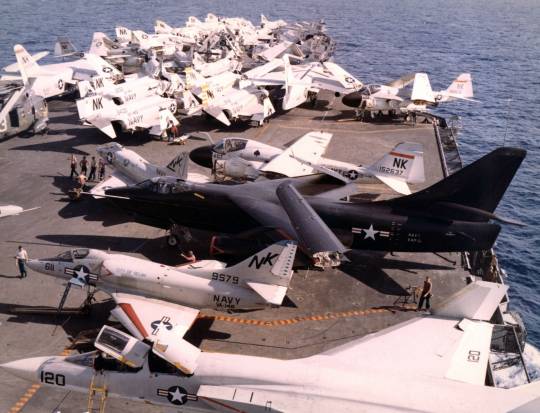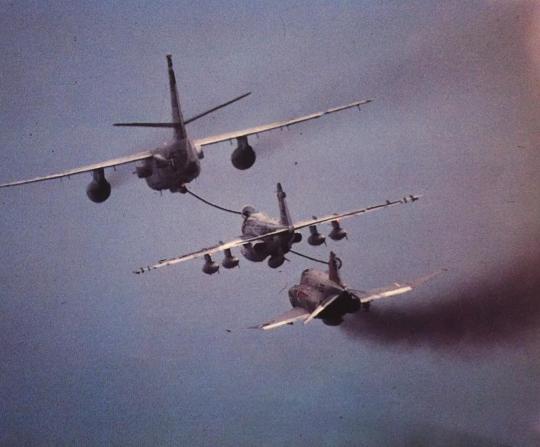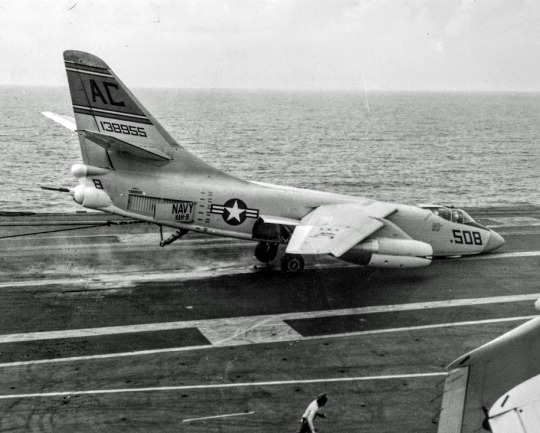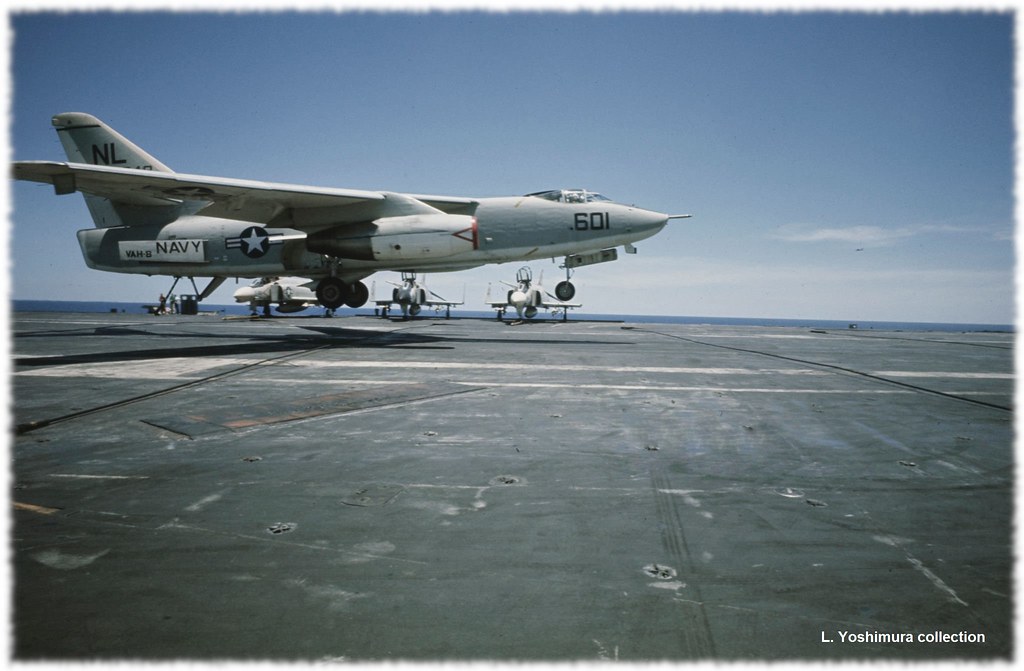#Douglas A-3 Skywarrior
Explore tagged Tumblr posts
Text

Two Douglas EA-3B Skywarriors from Fleet Air Reconnaissance Squadron 2 (VQ-2) fly past Gibraltar.
Photographed by PH3 Franklin P. Call, USN., on June 20, 1991.
National Museum of the U.S. Navy: 330-CFD-DN-SC-92-01461
#Douglas A-3 Skywarrior#Douglas A-3#A-3 Skywarrior#A-3#Skywarrior#Douglas#EA-3B#Attack Aircraft#Strategic Bomber#A3D-2Q#Electronic Warfare Aircraft#Aircraft#Fleet Air Reconnaissance Squadron 2#VQ-2#United States Navy#U.S. Navy#US Navy#USN#Navy#Gibraltar#June#1991#my post
43 notes
·
View notes
Text

A U.S. Navy Douglas A3D-1 Skywarrior in a jet-assisted take off from the runway at Naval Air Station Jacksonville, Florida, 1950s.
@CcibChris via X
#a 3 skywarrior#Douglas aviation#bomber#nuclear weapons#navy#aircraft#us navy#aviation#carrier aviation#cold war aircraft#vietnam war aircraft#aviation military#aviation military pics#military aircraft#military aviation
38 notes
·
View notes
Text

Ranger 16 landing on the USS Kitty Hawk - Feb 1987
#Navy#USN#Douglas#EA-3#EA-3B#Skywarrior#electronic intelligence aircraft#Reconnaissance aircraft#cold war#carrier landing#jet#Military aviation
38 notes
·
View notes
Text
F4D!

Back when there was more than one type of plane on a carrier deck.
85 notes
·
View notes
Text

A Douglas A-3 Skywarrior NL-601 of Heavy Attack Squadron #8 (VAH-8) approaches the landing strip of the USS Constellation (CVA-64), a Kitty Hawk-class supercarrier, off the coast of South Vietnam, 16th August 1966. Three McDonnell Douglas F-4 Phantom II aircraft are visible in the background.
10 notes
·
View notes
Photo

From the front: North American A-5 Vigilante, Grumman A-4 Skyhawk, Douglas A-3 Skywarrior, Grumman A-6 Intruder, McDonnell Douglas F-4 Phantom IIs, and a Sikorsky SH-3 Sea King, on the flight deck of USS Constellation.
#North American A-5 Vigilante#Grumman A-4 Skyhawk#Douglas A-3 Skywarrior#Grumman A-6 Intruder#McDonnell Douglas F-4 Phantom II#Sikorsky SH-3 Sea King#USS Constellation#carrier#aviation
23 notes
·
View notes
Text
It succeeded the Douglas A-3 Skywarrior as the Navy's primary nuclear strike aircraft, but its service in this capacity was relatively brief due to the deemphasising of manned bombers in American nuclear strategy. A far larger quantity of the RA-5C tactical strike reconnaissance variant were also procured by the service, which saw extensive service during the Vietnam War.




North American A-5 Vigilante, carrier-based supersonic bomber. Before the 1962 unification of Navy and Air Force designations, it was designated A3J.
37 notes
·
View notes
Photo

Douglas A-3 Skywarrior заправляет A-6 Intruder, который заправляет F-4 Phantom
6 notes
·
View notes
Video
Vietnam war by Linh Yoshimura Via Flickr: A Douglas A-3 Skywarrior NL-601 of Heavy Attack Squadron #8 (VAH-8) approaches the landing strip of the USS Constellation (CVA-64), a Kitty Hawk-class supercarrier, off the coast of South Vietnam, 16th August 1966. Three McDonnell Douglas F-4 Phantom II aircraft are visible in the background.
#A-3 Skywarrior#VAH-8#USS Constellation#CVA-64#US Navy#Vietnam war#F-4 Phantom II#McDonnell Douglas F-4 Phantom II
14 notes
·
View notes
Text

A U.S. Navy Douglas A3D-2 Skywarrior (BuNo 138955) of heavy attack squadron VAH-9 Hoot Owls pictured after its nose wheel collapsed during recovery on board the carrier USS Saratoga (CVA-60), 1959-1960. Note the open canopy. As a high altitude strategic bomber the A3D (after 1962 A-3) was not equipped with ejection seats and the crew was expected to jump off with parachutes in case of an emergency. NARA Image
51 notes
·
View notes
Text
AT THE POINT OF THE SPEAR
The A-3B was only operational in its designed role for a short time, from 1957 to 1964. At the type's peak service, fully eight heavy attack squadrons on the Essex- and Midway-class carriers were equipped with Skywarriors. By the early 1960s though, the manned bomber had been replaced, at least as far as the Navy was concerned, with ballistic missiles launched from submarines, and the A-3 and the A-5 that had been intended to supplant it were relegated to tanker and recon duties. During the early stages of the war in Vietnam, Whales took part in bombing raids, though the lack of ejection seats caught up with the type here, resulting the in grim 'All 3 Dead" moniker. A-3s also performed mine-laying duties until 1967, but bombing tasks were gradually handed over to smaller, more agile craft like the A-4 and A-6. The EA-3 and RA-3 continued to support US efforts in Southeast Asia however, with EA-3s flying out of Da Nang performing ELINT gathering from Haiphong in the north all the way down across the Ho Chi Minh Trail. RA-3s meanwhile were imaging areas previously unmapped; some of them were fitted with IR cameras to monitor troop movements at night.

-A Skywarrior from VAH-4 "Fourrunners" drops a Mk.83 bomb on a target in South Vietnam in 1965. VAH-4 was based on the aircraft carrier USS Oriskany (CVA-43) at this time. | Photo: US Navy.
One of the main roles the Whale fulfilled over SEA was that of aerial tanker. During 1967, 83 A-3Bs were modified into dedicated tankers as KA-3Bs. Some KA-3s were further modified to EKA-3s, which allowed aircraft to carry jamming equipment without sacrificing fuel carrying capacity. More than one damaged aircraft was nursed back to a carrier or land base by continual tankings from a KA or EKA Whale.

-An EKA-3 from VAQ-135 "Black Ravens" refuels an F-8J from VF-211 "Checkmates" off the coast of Vietnam in 1972. | Photo: US Navy
Eventually time caught up with the Skywarriors, with most of the A-3, TA-3 and RA-3 types being retired in the middle to late 1970s. The EKA-3s had their jamming equipment removed in 1975 and were returned to KA-3 specs, and the type were were finally retired in the 1980s. The last operational deployment of a Skywarrior was during Desert Shield/Storm in 1990-91, when two EA-3Bs from VQ-2 flew 41 missions. These aircraft were finally put to pasture in September of that year, bringing an end to the A-3's operational career.

-One of the last EA-3Bs in service, after the end of Desert Storm. | Photo: US Navy
TESTING, TESTING
In addition to being used as test mules for their own program, several Whales were used for various test programs through the years, starting with the YA-3A pre-production model, which was turned over to the Pacific Missile Test Center in the early 1960s. One of the programs that used A-3s for test purposes was the XASM-N-8 Corvus nuclear-armed anti-radiation missile.

-Skywarrior BuNo 138944 during a test launch of the ASM-N-8 missile. | Photo: US Navy
Another A-3, designated NA-3A, was modified with an AWG-9 radar and used to test the XAIM-54 Phoenix missile for the F-111B.

-An XAIM-54A Phoenix air-to-air missile is launched from the Douglas NA-3A Skywarrior (BuNo 135427) on 8 September 1966. | Photo: US Navy
The NA-3 was later used during the development of the B-2 Spirit stealth bomber.

-20+ years separate these two aircraft, though they shared the same mission. | Photo: Pacific Aviation Museum.
Skywarrior BuNo 144834 was designated the NRA-3B, and participated in numerous test programs for Hughes and Raytheon, oft times with different "nose jobs" and underwing cargo over the years.

-The NRA-3B nicknamed 'Snoopy', equipped with electronic warfare (jammer) pods, at the Pacific Missile Test Center, Point Mugu on 5 Apr 1982. | Photo: US Navy
Raytheon, having purchased Hughes in 1996, continued operating a number of A-3 variants up until 2011, when BuNo 144865, the last flyable Skywarrior, was flown to NAS Pensacola for retirement and eventual display at the Naval Aviation Museum.

-The NEA-3B makes its final landing at Forrest Sherman Field on board Naval Air Station (NAS) Pensacola, on June 30, 2011. | Photo: US Navy

-An A3D-1 Skywarrior at NAS Jacksonville prior to 1955. The gloss Sea Blue scheme seen here was replaced by a gull gray over white scheme when the type entered service. | Photo: US Navy
FLIGHTLINE: 173 - DOUGLAS A3D/A-3 SKYWARRIOR
Designed as a strategic bomber for the post-WW2 US Navy, the A3D wound up having one of the longest service lives of any carrier-based plane.
In January 1948 the Chief of Naval Operations issued a specification for a new aircraft, the Navy's first strategic bomber, to operate from the planned United States-class supercarriers. This aircraft, expected to be jet-propelled, would be capable of carrying a 10,000 pound bomb load, made up of conventional or nuclear weapons, and would have greater speed and range than existing attack aircraft like the AJ Savage. The total weight of the new plane could not exceed 100,000lbs, a size unprecedented in carrier-based aircraft to date. Eight manufacturers initially responded to the request, but only Douglas and Curtiss-Wright would continue in development, with the rest dropping out over concerns with the supercarrier program and/or difficulties in meeting the requirements and weight limitations.
Douglas' chief designer Ed Heinemann, reasoning that the US-Class was not likely to be produced, proposed a somewhat less ambitious aircraft that would weigh 68,000lbs; still a large aircraft for carrier operations, but one that could serve aboard the existing Midway- and Essex-class ships. Additionally, Heinemann reasoned that the rapid pace of advancements in atomic weapons technology would result in smaller, lighter bombs. Late in 1948, both Douglas and Curtiss received design contracts for their proposals, though the latter was unable to meet the 100,000lb weight requirement and was eliminated. In April 1949, the United States-class carriers were canceled, vindicating Heinemann. In July of the same year, Douglas received a contract for two flight-capable prototypes as well as a static test airframe of their new bomber, designated the XA3D-1 Skywarrior. Two years later, the USAF, seeking a replacement for the B/A-26 Invader, signed a contract for their own version of the A3D, designated the B-66 Destroyer.
WARRIORS OF THE SKY

-Orthograph of the A3D, including views of later variants. | Illustration: Dr. Dan Saranga
The A3D was of largely conventional construction, with the two jet engines housed in pods under the wings, which were swept at 36°. Half-span automatic slats were fitted, as well as flaps from the root to the wing hinge and ailerons from the hinge to the wingtip. For stowage in the carrier's hangar deck, the outer third of the wings folded up, lying almost flat against the rest of the wing, and the tail folded to the starboard. Two large hydraulically-operated speedbrakes were mounted on either side of the fuselage. The crew of three (Pilot, bombardier/navigator (B/N) and crewman/navigator (C/N)) sat under a framed canopy, with the C/N facing rewards and remotely operating a tail-mounted, radar-guided twin 20mm 'stinger', though this was later removed. In order to save weight, no ejection seats were included, instead the crew would bail out via the entry hatch (it was reasoned that the plane would generally be flown at higher altitudes, thus the lack of ejection seats was not an issue). This lead some crews later in the type's service life to joke that A3D stood for "All 3 Dead". Up to 12,000lbs of munitions could be carried in the bomb bay, usually in combinations of 12 500lb Mark 82 bombs, 6 1,000lb Mark 83 bombs, 8 1,600lb armor-piercing bombs, 4 2,000lb bombs, or 1 free-fall nuclear weapon. A drop-down spoiler in front of the bomb bay opened automatically to prevent buffeting or stores hanging up in the plane's slipstream. Bomb delivery will aided by an AN/ASB-1A radar system mounted in the nose.

-The first Douglas XA3D-1 Skywarrior, Bu. No. 125412, during its first flight. | Photo: US Navy
The first XA3D-1 prototype took its maiden flight on 28 October 1952 at Muroc Air Base, fitted with Westinghouse XJ40-WE-3 engines. The aircraft flew well, but the Westinghouse jets, already well behind schedule, proved to be underpowered, and both XA3Ds were refitted with P&W J57-P-1 engines. The Navy was pleased with the aircraft, and contracted a further YA3D-1 pre-production model, as well as 49 A3D-1 production models. The A3D-1 differed from the X and YAD3 only in minor details; the production aircraft were fitted with J57 engines from the start, and had redesigned canopies with more glazing. Early Skywarriors were painted in the then-standard dark sea blue scheme, but were later repainted with the new gull gray over white colors. The first A3D-1 took its maiden flight on 16 February 1953, and the Skywarrior entered service with VAH-1 at NAS Jacksonville in March 1956. Crews referred to the plane as the 'Whale', and were quite pleased with the A3D.

-An A3D-1 being catapulted from a carrier. | Photo: US Navy
In addition to their operational role, several of the A3Ds were converted for tests or to serve other roles. One aircraft, designated the A3D-1P, was used as the prototype for the A3D-2P photo-reconnaissance model, with a suite of cameras taking up the bomb bay. Five other aircraft were converted into A3D-1Q electronic intelligence (ELINT) gathering aircraft, with the bomb bay being filled with electronic equipment and four electronic officers (EO). In addition to the internal changed, cheek fairings were added on either side of the forward fuselage, as was a ventral canoe fairing and a fairing on top of the tail fin.

-Two A3D-1Q aircraft from Fleet Air Reconnaissance Squadron 1 (VQ-1) "World Watchers ". | Photo: US Navy
WHALE'S TAILS
The definitive production model of the Whale was the revised A3D-2, introduced in 1957. The -2s' wing was larger (812 ft² versus 779 ft²), and the airframe was stronger over all, which resulted in increased empty and max weights (39,410 lbs and 82,000lbs respectively). The J57-P-1 engines were replaced by upgraded J57-P-10 models, giving the -2 a slight increase in speed, ceiling and range. The bomb bay was redesigned, allowing the Whale to carry a wider range of munitions, including air-dropped mines. An inflight refueling probe was added, as were provisions for a "buddy" refueling plug-in that would add an additional 1,000 gallons of fuel and a retractable refueling hose & drogue assembly. Early A3D-2s retained the cannon tail, pointed nose and half-span flaps of the -1 spec, these were replaced by a dovetail fairing housing ECM equipment, snub nose and full-span flaps in the later batches, and earlier machines were later brought up to the same configuration.

-An A3D-2 from Heavy Attack Squadron 2 (VAH-2) "Fourrunners". | Photo: US Navy
In addition to the bomber version, several mission-specific A3D-2 variants were built. Based off the YA3D-1P, 30 A3D-2P photo recon Skywarriors were built, with the maiden flight of the type on 22 July 1958. All but the last two lacked the modified wing of the -2, although all had the refueling probe. Twenty-one EW variants were built, one YA3D-2Q prototype and 20 production A3D-2Qs. Like the -1Q before it, the -2Q had a ventral canoe fairing as well as one on top of the tail, but lacked the cheek blisters. The modified bomb bay still housed four operators, although now there were three windows, EWOs on older models apparently having complained about not being able to look outside. Various additional antennas were fitted and removed as upgrades or special missions changed the ESM/ECM/ELINT gear. The twenty production models had an in-flight refueling probe and dovetail fairing, and all were eventually fitted with the new wing. The last new-build variant was the A3D-2T B/N trainer, which first flew on 29 August 1959. The cockpit of the trainer was modified, with the rear-facing gunner's seat removed and a forward-facing trainee's seat installed. The same pressurized cabin from the -2Q was fitted, with four additional trainees and an instructor seated below. Four windows were installed on the left side along with three on the right, as well as a camera to record the bomb drops for later scoring. Two simulated nuclear bombs could be mounted under either wing. With the delivery of the final -2T in 1961, the last of 283 A3D Skywarriors was completed.

-An A3D-2P of VAP-61 "World Recorders" showing some of the cameras that could be carried. | Photo: US Navy

-An A3D-2Q from Fleet Air Reconnaissance Squadron 2 lands on the carrier Kitty Hawk. | Photo: US Navy

-A3D-2T from Reconnaissance Heavy Attack Squadron 3 (RVAH-3) at NAS Sanford. | Photo: US Navy
After the 1962 Tri-Service designation consolidation, the Skywarrior's various models were redesignated as follows:
A3D-1: A-3A
YA3D-1P: YRA-3A
YA3D-1Q: YEA-3A
A3D-1Q: EA-3A
A3D-2: A-3B
A3D-2P: RA-3B
A3D-2Q: EA-3B
A3D-2T: TA-3B
After production concluded, existing aircraft were modified for other missions. One of the EA-3As and five of the TA-3Bs were modified into VIP transports, with 6-9 airliner-type seats, bunks and a galley. The EA-3A was eventually redesignated the VA-3B, while two of the TA-3Bs were redesignated UA-3B. Eight of the RA-3Bs were modified into ERA-3B electronic aggressor aircraft, which were used to train other Navy crews in counter-ECM tactics during exercises. The ERA-3Bs were fitted with the same ventral canoe radome and tail fairing as the EA-3B, as well as chaff dispensers and four ram-air turbines (RAT) to power everything. During missions, two AN/ALQ-76 jammer pods were also carried, one under each wing. The ERA-3s were not operated from aircraft carriers, as the equipment was too delicate for catapult takeoffs or arrested landings.

-An ERA-3B in flight. | Photo: US Navy
#aircraft#aviation#avgeek#airplanes#cold war#airplane#cold war history#coldwar#aviation history#us navy#douglas aircraft company#a3d skywarrior#a3 Skywarrior#a3d whale#a 3 whale
5 notes
·
View notes
Text

Douglas A-3 Skywarrior. A U.S. Navy Douglas A-3 Skywarrior aircraft on the ground at Naval Missile Center, Point Mugu, California, USA. 1960s
@Destroye83 via X
#a 3 skywarrior#douglas aircraft#test bed#aircraft#navy#aviation#us navy#carrier aviation#vietnam war aircraft#cold war aircraft
10 notes
·
View notes
Text

Douglas ERA-3B Skywarrior from USN VAQ-33 seen departing Miramar - November 1988
#USN#Navy#Douglas#ERA-3B#Skywarrior#Whale#A-3#ELINT#electronic attack#Electronic Intelligence#Reconnaissance aircraft#Military aircraft
32 notes
·
View notes
Video
Douglas A-3 Skywarrior by Willard Womack Via Flickr: The Skywarrior entered service in 1956, and withdrawn1991. Making it the longest serving plane in the Navy The Air Force version was the B-66 Destroyer .
3 notes
·
View notes
Text
Northrop Grumman E-2 Hawkeye
Grumman C-2 Greyhound
Douglas A-3 Skywarrior
Grumman A-6 Intruder
North American A-5 Vigilante
Grumman S-2 Tracker
LTV A-7 Corsair II
Lockheed S-3 Viking
Grumman F-14 Tomcat
Sikorsky SH-3 Sea King

183 notes
·
View notes

